[Editor’s note: This is excerpted from ‘Reservations: The Pleasures and Perils of Travel’ by Steve Burgess, contributing editor of The Tyee, now out with Douglas & McIntyre. Burgess will discuss his funny and probing book on May 2 at the Vancouver Public Library main branch.]
It’s a warm June day, and the catamaran Salish Sea Dream has been on the water since 2:30. After easing out of its Granville Island dock, the boat, with a full load of 95 passengers and five crew, has wandered between the mainland and Vancouver Island, tiptoeing among the Gulf Islands and bouncing over light chop in the Strait of Georgia, searching for its quarry. So far it has encountered a community of placid harbour seals clustered around a small reef, a lone bald eagle awaiting its mate beside a massive nest on an otherwise uninhabited island, a few stately BC Ferries ships, small lighthouses, the idyllic homes and cottages on the waterfront of Gabriola and other Gulf Islands. Little more.
The catamaran is crossing open water now, pointed back toward its Vancouver base. Passengers gaze at the horizon or their phones. There is an air, if not of disappointment, at least of resignation. People are not scanning the waves with the same eagerness as at 3:30. Abruptly, the Salish Sea Dream makes a sharp turn to port. People look up, stand, move to the railings. This sudden swerve is surely significant. Marine biologist and tour guide Lucas Crosby confirms it — the course correction has been ordered by first mate Sandy Quinn, stationed on the bridge above us with binoculars.
“Sandy spotted blows,” Crosby says. At last we are on the track of whales. The Salish Sea Dream is owned by Prince of Whales, one of many whale-watching tour operators in B.C. (The company got an unexpected plug in 2019 when President Trump tweeted about meeting the “Queen of England and the Prince of Whales,” but it is anyone’s guess whether any bookings or cancellations resulted.)
In a 2007 essay, “Ecotourism: Pondering the Paradoxes,” James Higham and Michael Lück made two related points — one, that ecotourism was ideally experienced without a long, emissions-heavy journey. Secondly, that ecotourism is best done in places where no intrusive infrastructure must be built. The traveller who seeks a wilderness experience ought to depart, ironically, from a place where wilderness is mostly a distant memory. “Cities offer well-developed transport and service infrastructures for locals and tourists alike,” they wrote.
Vancouver might be the poster city for Higham and Lück’s argument. And whale watching fits the urban ecotourism bill precisely. Prince of Whales has other bases in Victoria and on Telegraph Cove on Vancouver Island, but their Granville Island dock is a fairly short bicycle ride from my apartment. After over 35 years in Vancouver, 2023 is when I take my first whale-watching tour. It is often said that many New Yorkers have never visited the Statue of Liberty; here I would seem to be the Vancouver equivalent.
Whale watching from an urban base offers advantages, points out Prince of Whales head of marketing and communications Claudia Milia. “We have all of our staff in Victoria and Vancouver, we don’t have to relocate them,” she says. “We don’t have to pay for transportation or have them move around. It’s a lot more convenient than remote places in which employees have to find accommodation, or if there is no accommodation and they have to transit there, which is not great for the environment.”
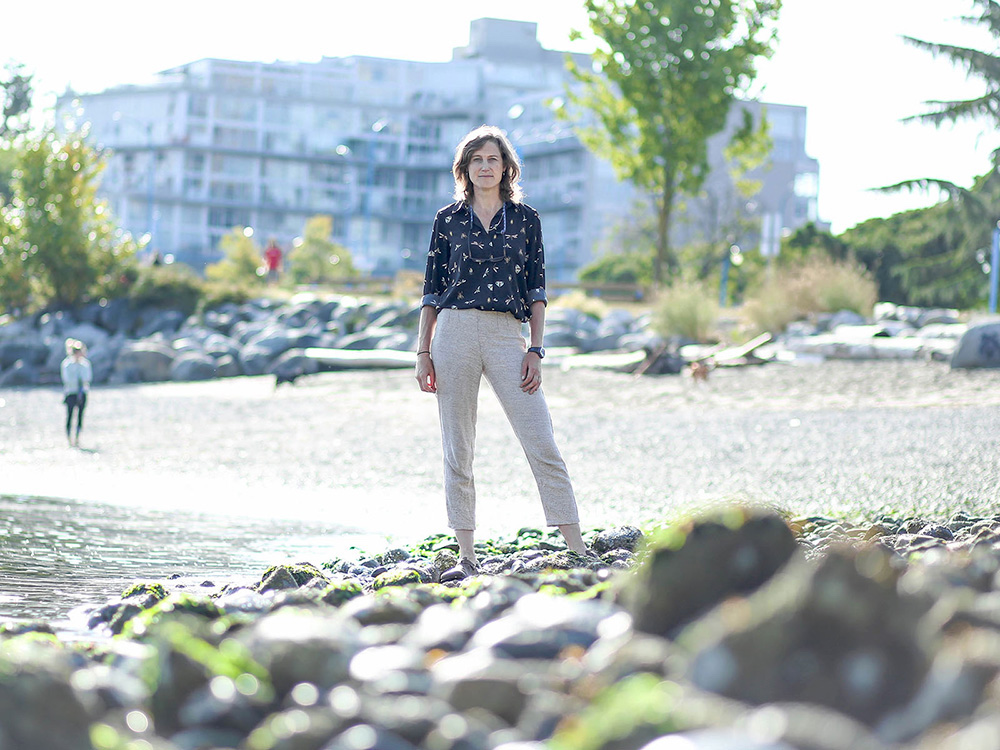
The Strait of Georgia holds large humpbacks and greys, but the most commonly seen cetaceans here are orcas, a.k.a. killer whales, which are members of the dolphin family. Big, fast and relentless, they are like happy little Flippers that have been bitten by radioactive great white sharks to become apex predators.
The transient variety are also known as Bigg’s orcas, after the late Michael Bigg, a Canadian marine biologist whose research in these very waters provided breakthroughs in understanding their behaviour, identification and the vulnerability of the relatively small population. The name fits — Bigg’s orcas are indeed large, preying on seals, sea lions and harbour porpoises, and sometimes striking their prey with such force that the stunned target will fly metres into the air.
It was Michael Bigg who discovered that a smaller local group, called the southern resident killer whales, were a distinct population. Unlike the transients, the residents eat only salmon, and the decline of salmon stocks has put that population in such danger that whale-watching boats like ours are not permitted to pursue or observe them. They are to be left alone. The marine biologists on board can easily distinguish between the smaller residents and the relatively supersize transients.
Whale-watching boats in Canada and the United States have adopted strict policies to minimize their impact. They are not allowed to approach closer than 200 metres to orcas. If the orcas or whales approach the boat themselves, the vessel will cut its engines and drift. (Crosby tells me of a humpback named Nike who loves whale-watching boats. “He’ll see us and come right over,” he says. Is it sexual? There’s no judgment.)
Lauren Laturnus, a field assistant to the Boundary Pass whale project organized by the Saturna Island Marine Research and Education Society and Simon Fraser University, spent the summer of 2022 looking at the whale-watching industry and other boats in this area. “Whale-watching companies that are part of the Pacific Whale Watch Association [Prince of Whales among them] often have experienced and educated crew members or researchers that are able to collect data on whale identification, movement and behaviours,” Laturnus says. “The PWWA also collaborates with many conservation groups that are dedicated to researching and restoring marine environments.
“Marine mammal regulations and interim orders have been put in place to limit the disturbance that vessels can have on whales. The problem is the whale-watching industry does not always comply. I conducted five months of land-based research on Saturna Island in the summer of 2022 and regularly saw whale-watching boats getting too close to whales, following them for longer than the regulated time limit, leapfrogging — where the boats would position themselves to be directly in the whales’ path before turning their engine off — as well as entering the interim sanctuary zone, put in place to provide a safe area for southern resident whales.
“Currently, there is very little enforcement on the water and until companies are held accountable, there will continue to be players who break the rules and keep the industry open to justified criticism.”
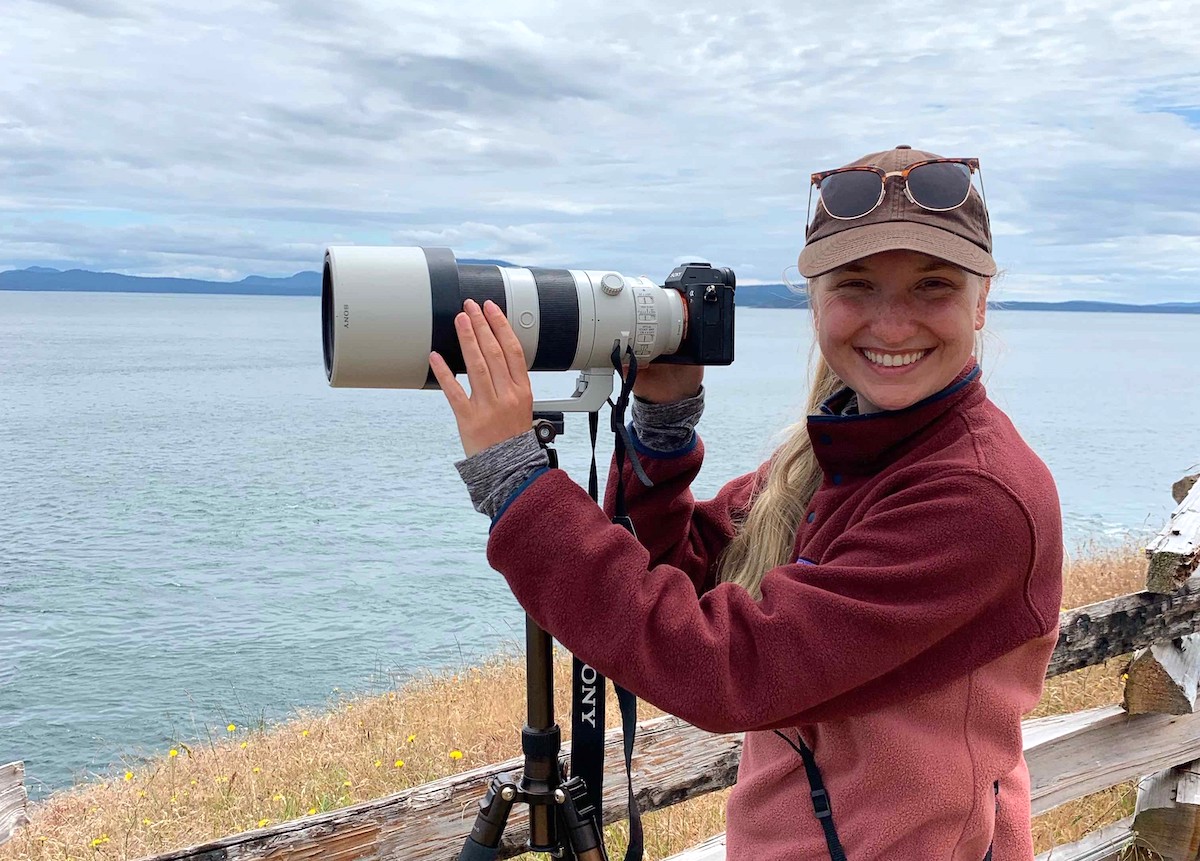
Prince of Whales boats respect the rules. But the small deck crew of the Salish Sea Dream — Crosby and fellow staffers Petra Catsi and Róisín O’Sullivan — are not without qualms.
“We are educating people on these tours,” Catsi says, “and we hope the education outweighs any harm we might do. We are out here burning fuel, after all.”
“There has always been an uneasy relationship between this industry and science,” says Dr. Ruth Joy, who lectures at Simon Fraser University and is a member of the Sea Mammal Research Unit. “Many of the whale-watching staff are trained scientists that love whales, but their industry is dependent on paying guests who want to be up close and personal with whales, and these same staff want to deliver this on their trips.”
That dual identity is clear aboard the Salish Sea Dream. Catsi may have spent years studying whales and ocean-going mammals, but today she is also tasked with dispensing coffee, hot chocolate and Twix bars. (The canteen task rotates among the staff — next voyage it will be Lucas or Róisín handing out refreshments.) Still, Catsi has the satisfaction of knowing that she played a key role in a recent whale rescue. The previous year a Prince of Whales catamaran spotted a young humpback named Scuba, who was acting weird.
“He was breaching [lunging out of the water] over and over,” Crosby says. “That’s great for whale watchers, but it’s not normal.” It was Catsi who spotted the reason. “There’s a rope in there,” she said. Like many humpbacks who swim these waters, Scuba had become entangled in fishing gear. A call was made to the Department of Fisheries and Oceans and a team dispatched to try to free Scuba. The operation was a success, though recent sightings of Scuba have shown the resulting scars.
Three and a half hours into our tour the Salish Sea Dream is at last tracking whale activity. Crosby points to a bright stretch of water ahead, near Gabriola Island. “See the blows?” he says. Honestly, I don’t. It all looks like whitecaps to me. But Crosby is confident. A small prize is offered to any passenger who is the first to see a whale but the crew have been to this rodeo before. “It’s hard to beat Sandy,” Crosby says.
Tracking whales is a pursuit that unites commercial operators, casual boaters and marine biologists. “We can track what they’re doing, their behaviour, how they’re moving,” says Milia. “And this is of great importance to researchers.” A website called Happywhale gives whale watchers amateur and professional around the world a chance to report sightings and create a map of whale movements and habitats.
“Whether Prince of Whales and other companies are actually in harmony with whales is open to interpretation,” says Dr. Joy, “especially if you’re a whale. But the data they collect is making its way more and more into the local community as citizen scientists play a more active role in data collection and analyses, as federal governments struggle to afford field programs.”
“Realistically,” Milia says, “they [researchers] spend less time in the water than we do.” The boat slows when we reach the stretch of water where the spouts were seen. A scan of the surface reveals nothing but waves. We drift awhile, then turn and head back where we came. “There’s a lot of water out here,” Crosby says, “and these guys can disappear pretty fast. At top speed, they are faster than our boat.”
Nor is an orca a creature to be trifled with. At the time of our voyage reports from Spain have been all over the news, telling of orcas striking, damaging and even sinking small vessels in co-ordinated attacks like those usually launched against prey. Still, even putting aside the still-extant professional whaling industry, whales have suffered more damage from us than they could ever hope to repay.
We pass a BC Ferries vessel, a majestic white castle headed the other way. Ferry passengers could easily see whales by chance, which seems unfair. They only paid to get somewhere. Our passengers forked out for a show. It takes a while, with the boat executing a search pattern near the last sighting. But at last, showtime.
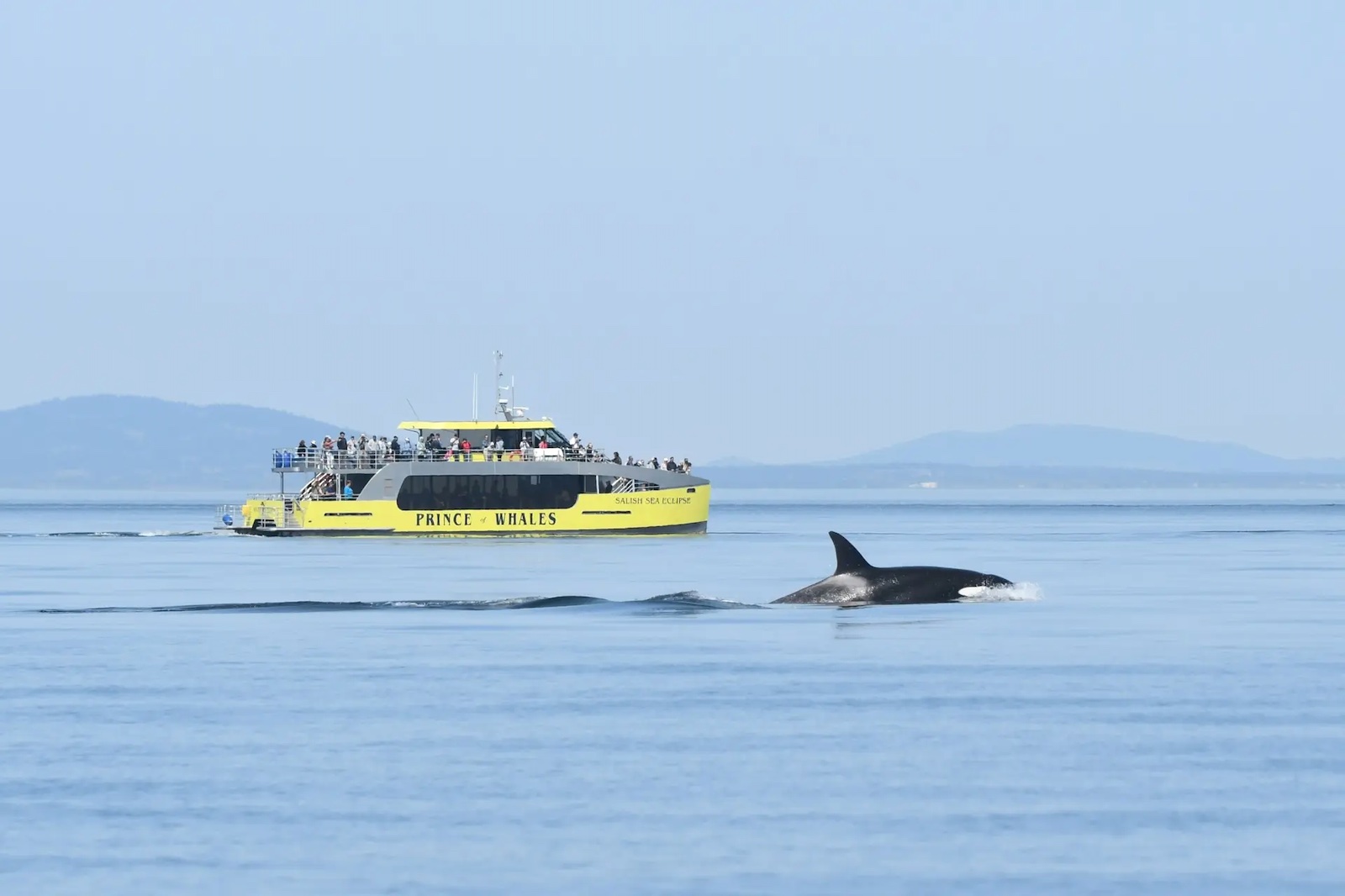
As Capt. Anthony Kaulfuss eases the catamaran into position, the passengers crowd to the starboard railing, phones aloft. A couple hundred metres away the surface is broken by shiny black forms, emerging from and plunging back beneath the waves. There appear to be four, one significantly larger than the rest. This, Crosby tells us, is pod T123. The matriarch is Sidney, orca T123, from whom the pod gets its designation. The larger whale is Stanley, a 23-year-old, seven-and-a-half-metre-long male. Stanley got his name because in 2011, the last year the Vancouver Canucks made the Stanley Cup final, he appeared in Vancouver Harbour like a magical talisman.
One of the young females is named Lucky. Sidney was pregnant with her when she somehow got stranded by an ebb tide in Prince Rupert. Locals kept Sidney and another whale hydrated until high tide allowed them to swim free, hence her calf’s subsequent nickname. The pod was seen hunting earlier today but now they are simply travelling, moving easily and steadily to the northwest.
Capt. Kaulfuss cuts the engine a couple of times to let them get farther ahead, and then we sneak up again. It’s Stanley who is the real showstopper here. He’s huge, his dorsal fin rising like a glossy black sail over the water. Everybody is recording but the resulting videos will likely make little impact on anyone who wasn’t on board. We are not really seeing a lot of whale skin. Yet the effect is no less awe-inspiring. I find myself gasping whenever Stanley surges back into view. No one is chattering. We can hear the whales breathing as they surface. Except for the phones, it’s like being in church.
After about 25 minutes we bid adieu to the pod and turn for home. It has been a longer-than-normal outing, lasting five and a half hours and covering 108 nautical miles. Everyone on board appears pleased. It seems no whales were interfered with on this day, though as Dr. Joy points out, you’d have to be a whale to know for sure.
The whale-watching industry boasts a lot of satisfied customers. A 2015 survey by Raincoast Conservation Foundation estimated whale watching generated between $16.8 and $24.5 million Canadian in annual revenue for B.C., creating up to 359 jobs in high season.
Globally, according to a 2017 survey conducted by whale researcher Erich Hoyt, whale watching brings in over US$2 billion and employs over 13,000 people. Marine biologist Petra Catsi is one of them. And she enjoys it. She cares about whales, studies them, watches them on almost every voyage. But she wonders, too, about the ethics of chasing wild creatures, like paparazzi after a princess.
“Does education and awareness balance the equation?” asks Catsi. “That’s the question.” ![]()
Read more: Books, Travel, Environment


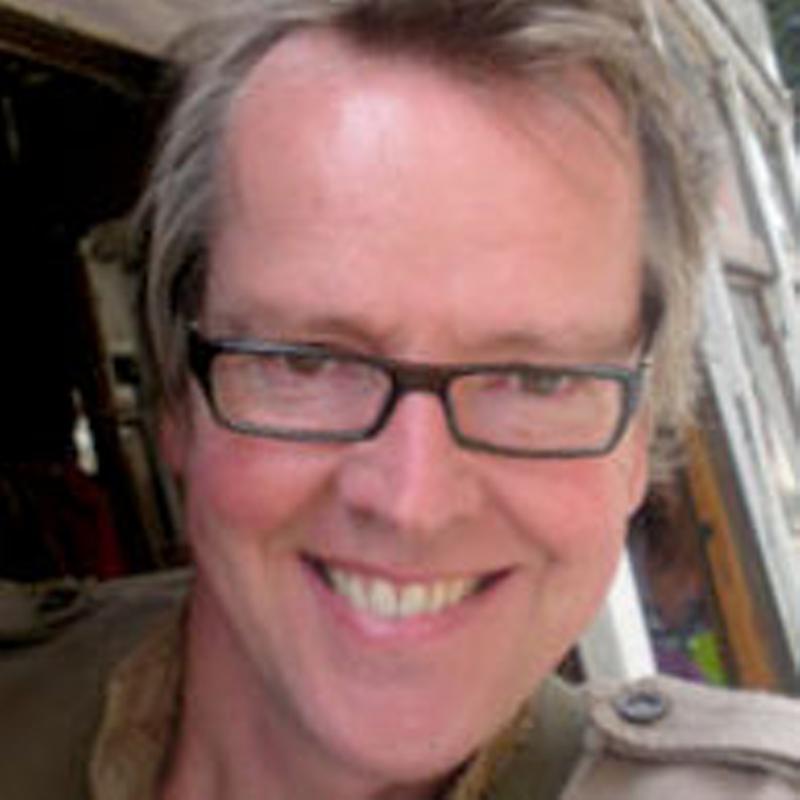

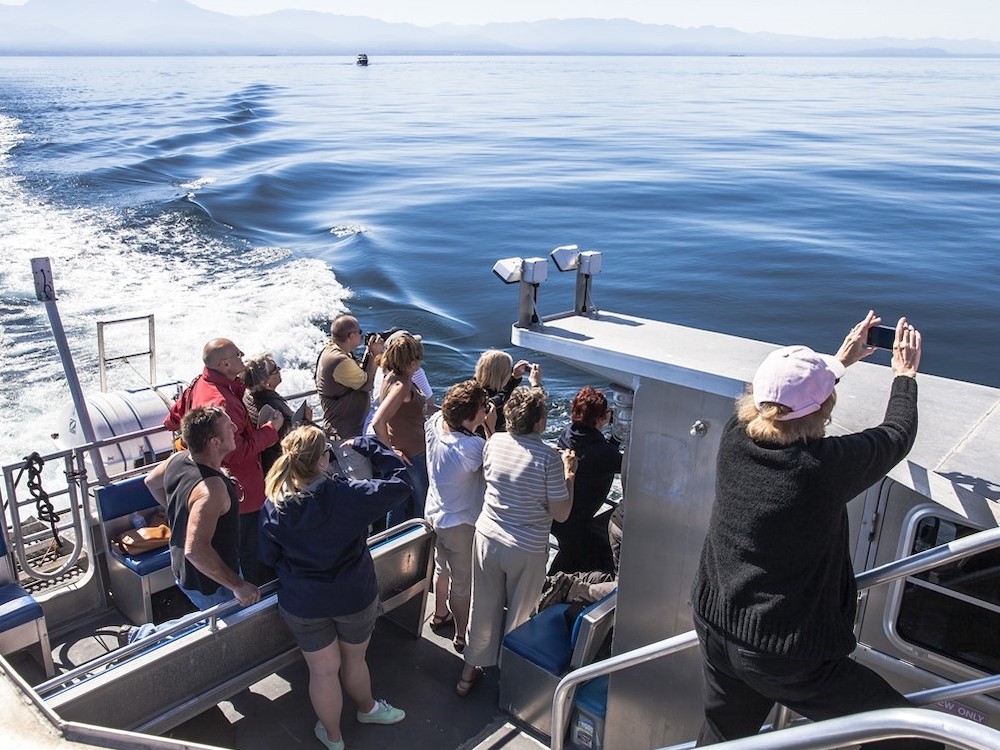












Tyee Commenting Guidelines
Comments that violate guidelines risk being deleted, and violations may result in a temporary or permanent user ban. Maintain the spirit of good conversation to stay in the discussion and be patient with moderators. Comments are reviewed regularly but not in real time.
Do:
Do not: